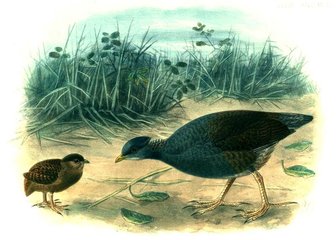Niaufoou Scrubfowl
Its natural habitat is tropical moist lowland forests. On Niuafo'ou it is most common on the central caldera. The Tongan Megapode, like all megapodes, does not incubate its eggs by sitting on them; instead the species buries them in warm volcanic sands and soil and allows them to develop. On islands in former parts of its range without volcanoes it presumably created mounds of rotting vegetation and laid the eggs there.

The Niaufoou Scrubfowl is classified as Endangered (EN), considered to be facing a very high risk of extinction in the wild.
Niaufoou Scrubfowl, So I would probably choose that one (at least that name came from two sources). I agree – this is the only island where the bird (still) occurs naturally, so Niaufoou (or better: Niaufo‘ou) it should be, although it's difficult to remember. Polynesian would seem to mean it occurs widely... More
Family : Megapodiidae
Genus : Megapodius
Species : pritchardii
Authority : Gray, 1864
